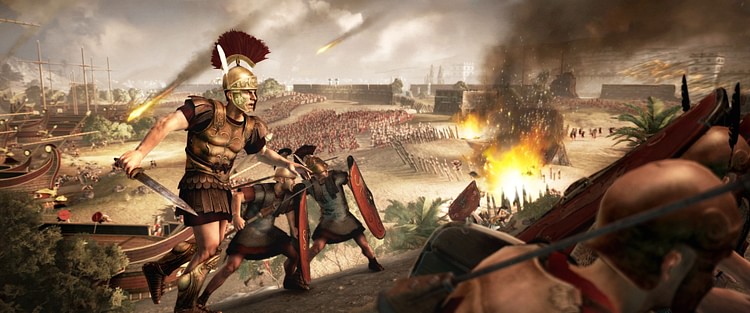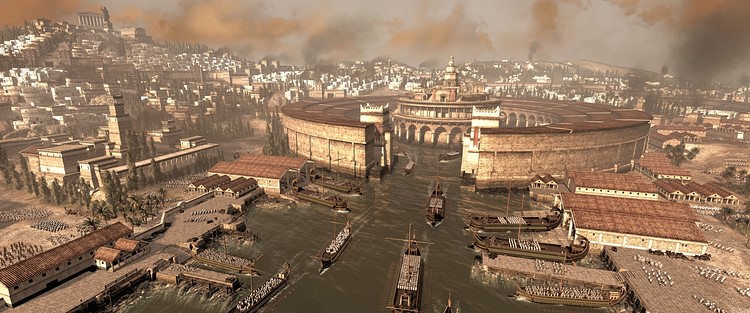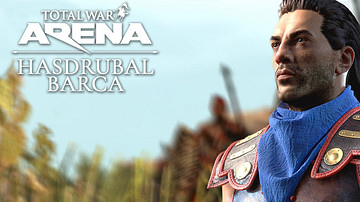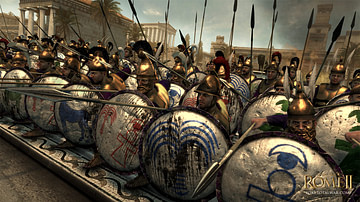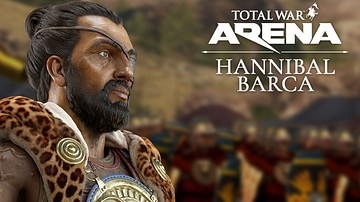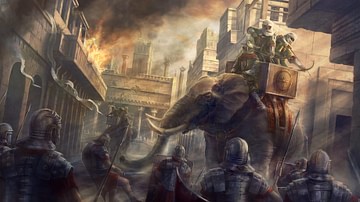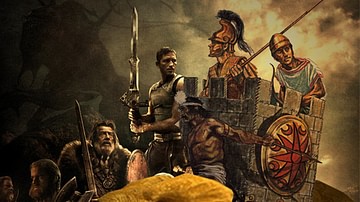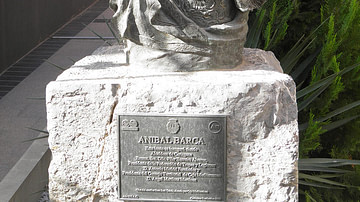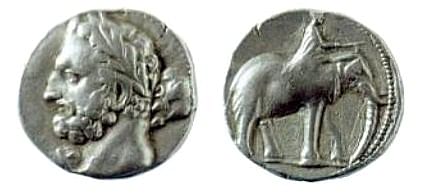
Hamilcar Barca (c. 285 – c. 228 BCE) was a Carthaginian general active in the First Punic War (264-241 BCE). He then quashed a rebellion closer to home between 241 and 237 BCE before returning abroad, where he successfully expanded Carthaginian interests in southern Spain. In these conflicts, Hamilcar had switched Carthage from a naval power to a land power with great success, and he firmly established the Barcid family as the ruling house of Carthage. He was the father of Hannibal Barca who continued his father's tactics and won major land battles in Italy during the Second Punic War.
Name & Family
'Hamilcar', from the Punic hml-qrt, means follower or servant of Melqart, the Phoenician/Punic god whilst 'Barca' is thought to derive from the Punic word barqa, meaning lightning, and was used in reference to Hamilcar's guerrilla tactics used in the First Punic War.
Hamilcar Barca was a member of the Barcid clan of Carthage and the father of Hannibal Barca, Rome's most notorious enemy, who crossed the Alps and caused havoc in Italy in the Second Punic War (218 - 201 BCE). In 237 BCE Hamilcar had famously taken his son, then nine years old, to the temple of Baal in Carthage and made him swear never to be a friend of Rome. Hamilcar's other two sons were Hasdrubal Barca and Hasdrubal Gisco, both of whom commanded during the Second Punic War.
First Punic War
After 15 years of fighting, there was still no end in sight to the Second Punic War. Carthage had beaten a Roman army in Africa, but Rome seemed able to replace their naval fleets at will. Sicily had been the principal battleground but had yet to see a decisive victory for either side. Then the enterprising Hamilcar Barca came to the fore. He replaced Carthalo, who had not been altogether unsuccessful, as the commander of the Carthaginian fleet.
Hamilcar first raided the Italian coast at Bruttium in 247 BCE, perhaps in search of booty to pay his mercenaries, and then landed on Sicily at Heircte near Panormus (Palermo). This position allowed Hamilcar to hold a mountain base and harass the rear of the Roman forces who were besieging Drepana and Lilybaeum, which were Carthage's last remaining strongholds on Sicily. The Romans responded by blockading Hamilcar, but he seems to have been able to break out regularly and continue his guerrilla tactics. As Carthage no longer had the resources for a large army, he could not face the enemy in an all-out battle, but he did manage to capture Eryx in 244 BCE, which became his new base. This turned out to further restrict his freedom of movement, but the Carthaginian commander continued to coordinate attacks on the Italian mainland, perhaps as north as Cumae. Still, without a significant force at his disposal (fewer than 20,000 men) and despite Polybius' praise that he was the best Carthaginian general of the war, Hamilcar's effect on the conflict was ultimately a limited one.
The end finally came on 10th March 241 BCE when the Romans defeated a Carthaginian fleet led by Hanno sent to relieve the besieged city of Drepana off the Aegates Islands (Isole Egadi). 50 Carthaginian ships were sunk, 70 captured and 10,000 prisoners taken. This loss was not huge, but after decades of war, it drove the cash-strapped Carthaginians to instruct Hamilcar to seek peace terms. Hamilcar then resigned his command but he would be needed again within months.
The Truceless War
Not only did the Carthaginians lose the First Punic War and so the control of Sicily but they were also compelled to pay huge reparations to Rome. Then the so-called Truceless War (also Mercenary War) broke out in 241 BCE. Carthage faced a joint rebellion of mercenary troops, understandably upset at not having been paid for their efforts in the first Punic War, Libyan groups seizing the opportunity of a weakened Carthage to rebel, and several cities looking for independence such as Tunis and Utica. Hamilcar Barca was recalled from Sicily and he joined Hanno the Great, who had made significant conquests in Libya while Hamilcar had been in Sicily, to quash the rebellion. First, Hamilcar broke the rebel siege of Carthage and then defeated an army led by Spendius near the Bagradas River. Hamilcar had managed to persuade the Numidian prince Naravas to defect with his cavalry force to the Carthaginian side, lured by the promise of Hamilcar's daughter for his wife. Hamilcar now had an army of 12,000 and 70 elephants with which to face the rebels.
Elsewhere, things did not go so well. Hippacra and Utica were both besieged, and Hanno was unable to free them. In 239 BCE a mercenary force took control of Sardinia and then defeated a Carthaginian army sent to re-take the island. In the same year, both Hippacra and Utica joined the rebels. The war was now becoming particularly brutal with atrocities committed on both sides. The rebels mutilated prisoners, and Hamilcar had his captives trampled on by elephants. Long-time rivals Hamilcar and Hanno could not agree on the best strategy and eventually the army was permitted to choose which general should lead them. They chose Hamilcar.
The war started to improve for Carthage when they were aided by Rome, who repatriated captured Carthaginian soldiers for free, and the tyrant of Syracuse Hiero, who feared that without Carthage then Rome might act at will in the central Mediterranean. Hamilcar broke off the second siege of Carthage by Mathos and headed inland where a rebel army awaited him. There, after several skirmishes, Hamilcar cornered the enemy at 'the Saw' (Prion), a ridge in the Libyan mountains. The rebel army was starved of supplies and eventually sought to surrender. Hamilcar refused and slaughtered all of them except for the commanders. These were taken to Tunis, the rebel capital, and crucified in full sight of Mathos' army. Meanwhile, Mathos had defeated a Carthaginian army, and he dealt the same treatment to the captured Carthaginian general. Mathos could not, though, resist a joint army of Hamilcar and Hanno, and he was driven out of the city and defeated at Byzacium. Finally, with the fall of the rebel capital in 237 BCE, Hippacra and Utica back on the Carthaginian side, and Libya now compliant, Carthage had regained control of its African empire. Hamilcar and the Barcid line would now dominate the Carthaginian political and military arenas for the next 35 years.
Hamilcar in Spain
Carthage was on the rise again and eager to create a wider Mediterranean empire. Without a significant fleet and having lost their strategically important fortresses in Sicily, Corsica and Sardinia, the Carthaginians, though, had to look elsewhere for a source of money to fund their armies. The answer was Spain. They had long since had control of the old Phoenician colonies there, and it had already proven a rich source of silver. Accordingly, Hamilcar Barca was dispatched in 237 BCE to expand Carthaginian territory, which he did, establishing his base at Gades (Cadiz) and founding a new city of Acra Leuce. He supplemented his original force of some 25,000 with local recruits and amassed a 50,000-strong army which included a corps of Numidian cavalry (supplied by Prince Naravas) and 100 elephants. Using a blend of terror and diplomacy Hamilcar relentlessly expanded his control over southern Spain. The riches from these campaigns were channelled back to Carthage. Hamilcar's move away from the traditional naval power of Carthage to a land force was reaping fantastic rewards.
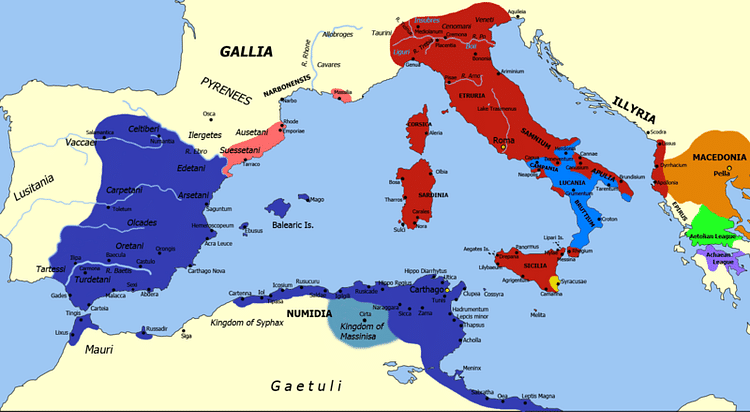
By the time Hamilcar had conquered southern and south-east Spain, Rome became suspicious of their old enemy's intentions. Envoys were sent to Hamilcar demanding an explanation. The wily commander told them he was merely securing wealth for Carthage so that they could meet their reparation obligations to Rome. Certainly, tribute in money, if not men, was extracted from local cities and new silver mines were worked. The Carthaginian's, in any case, continued campaigning in Spain. After the siege of Helice and betrayed by local allies, Hamilcar retreated and drowned while crossing a river in the winter of 229/228 BCE. Hasdrubal the Fair then took over command of the Carthaginian army. When he was replaced by Hannibal in 221 BCE, the Carthaginians broke the territorial agreement with Rome of 226 BCE not to cross the River Ebro and attacked Rome's ally Saguntum (Sagunto). This led to the Second Punic War and Hannibal taking the army across the Alps into Italy. Hamilcar had indeed got his wish that the Barcid line would be no friend of Rome.
